Growing cypresses for timber
NZFFA Information leaflet No. 21 (2005).
There is no doubt about it, if you want to grow trees in New Zealand for maximum profit with least risk, its very difficult to look beyond radiata pine. However, a lot of farm foresters feel that they would like to grow something other than radiata pine, something that produces a timber that is readily saleable, profitable, and reasonably easy to grow. Some of the cypresses fit this bill very well, probably better than any other species with the possible exception of Douglas fir (which is not an option on many sites). The main species likely to be grown are macrocarpa (Cupressus macrocarpa) and lusitanica (C. lusitanica), but there is also a place for Lawson cypress (Chamaecypris lawsoniana) and some of the Leyland cypress (X Cupressocyparis leylandii) clones.
Timber
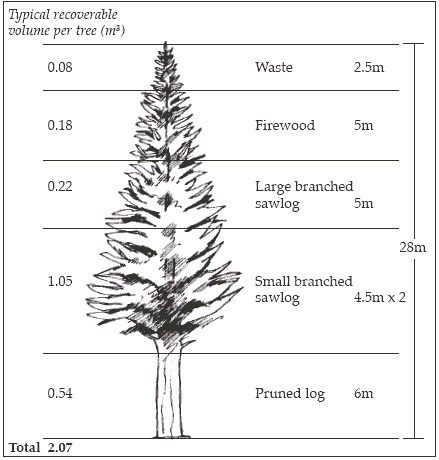
Macrocarpa timber has a good reputation in New Zealand because it has many desirable properties, including wood of medium density, good colour, figure and lustre, with good machining properties and finish, dimensional stability and natural durability. The timber has a subtle fleck, and often an attractive but not overpowering figure. Small green knots can add to the figure and are often not regarded as a defect. It is easy to saw and season and its wood properties are similar to those of kauri, making it suitable for boat building, veneers, furniture and joinery, as well as the more traditional uses of exterior joinery, weatherboards, and farm utility timber. If the sapwood is treated, small diameter material also makes excellent posts.
As far as is known, all the main cypresses grown in New Zealand produce a similar high quality timber, and the cypresses are amongst the most valuable softwoods traded on the international market. There is a strong demand for cypress timber in Asia, and this is not likely to diminish in future. To date, stumpages for macrocarpa have usually been about twice those paid for radiata logs of the same quality, but very few high quality logs have come on the market. The natural durability of the heartwood above ground is an advantage that can only become increasingly important as the world becomes more ‘chemical-conscious’.
Growth rates
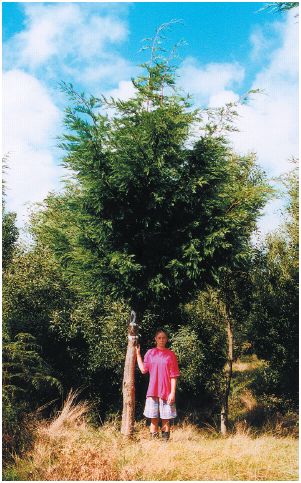
Although not as fast growing as radiata pine, growth rates of macrocarpa and lusitanica are still quite respectable by New Zealand standards. Once plants are well established, height growths of 80 to 150cm annually are the norm, so that at age 10 trees are commonly 8m (macrocarpa on average sites) to 12m (lusitanica on good sites) tall, with a mean dbh of 15 to 25cm. From then on, on reasonable sites, fully stocked stands usually have a mean annual increment in excess of 20m3/ha/annum. Because the cypresses are relatively shade tolerant, they can carry higher basal areas than radiata pine, and therefore final crop stockings can be higher, 400 to 500 stems per ha (sph) for macrocarpa and lusitanica, and up to 600sph for Lawson cypress.
With timely pruning and thinning, trees with a mean dbh of 60cm may be produced with rotations of 30 to 35 years for lusitanica. For macrocarpa, rotations are likely to be closer to 40 years, while rotations of up to 50 years will probably be required for Lawson cypress. Because small logs produce a timber very similar to large logs, they are usually readily saleable and rotations can be shortened if necessary. Stands on easy terrain with good access can also be production thinned, thereby enhancing the yield.
Siting
The cypresses as a whole will grow on a very wide range of sites, but when it comes to producing an economic return, they are certainly much more demanding than radiata pine. Lusitanica is best grown on warm sheltered sites protected from salt winds, and is therefore best planted in lowland areas of the North Island and the warmer parts of the South Island. Macrocarpa is more tolerant of exposed conditions, and probably heavier soils. It will also tolerate a much colder climate, but we have little good information on how much cold it can tolerate. The site requirements of Leyland cypress clones are similar to those of macrocarpa, but they will do better than macrocarpa on low fertility or drought-prone sites, and some clones are more tolerant of cold. Lawson cypress does best on cool moist sites, and will tolerate snow-prone sites, but it is very susceptible to root rot on heavier soils.
Cost of pruning
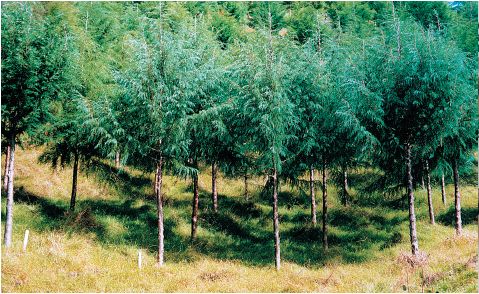
The cypresses are noted for the number of branches they produce, which makes them excellent subjects for trimmed hedges, but it does make life awkward when it comes to pruning to produce clearwood. At first sight, there seems to be a random mixture of branches on the trees, but closer inspection will usually reveal groups of heavier branches produced each spring. If the largest of these branches are removed, and any tight clusters of branches are thinned out, before the branches get too big, it does make clear pruning much easier later on. Nevertheless, clear pruning costs are likely to be high for trees grown from unselected seed, probably of the order of twice the cost per tree of pruning radiata.
There are on the market now a number of clones of macrocarpa, lusitanica, and their hybrids, selected for light branching and ease of pruning, and although they cost more than seedlings, pruning costs for these are not much more than pruning costs for radiata.
Another method of reducing pruning costs is to start pruning when the trees are quite small, and to prune annually. Pruning trials on unselected seedlings have shown that pruning to a gauge with a width in cm matching the seedling’s age does not affect height growth, and has only a minor effect on diameter growth provided the seedlings are well sited, e.g. a 4-year-old tree can be pruned to a 4cm gauge, and then as a 5-year-old, pruned to a 5cm gauge.
Canker
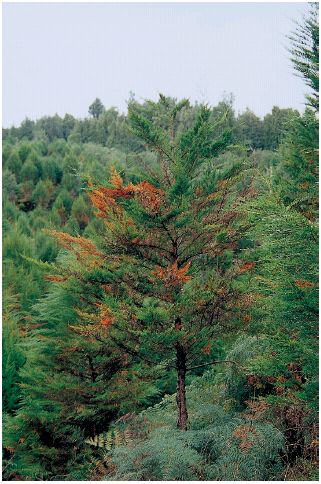
Canker is a disease which usually starts by killing the cambium of twigs, and can spread from these to larger branches and the main stem. If the cambium of the main stem is severely affected, there may be terminal dieback, the leader may snap off in strong winds, or the whole tree may die. It is very widespread and is probably present in all stands, although it is usually only a serious problem on warm sites, and then mainly in macrocarpa and the Leyland cypress clones. Some trees seem much more susceptible than others, but there is little evidence that there is a strong genetic base for this because some trees in a clone can be severely affected, while their genetically-identical neighbours remain free of disease.
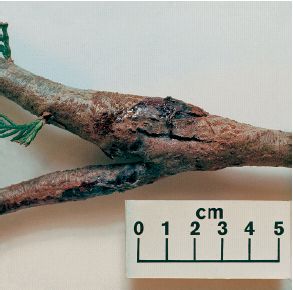
Attack is much worse where trees are severely stressed, particularly by drought, but attack can also be severe where trees are growing on fertile soils with a high nitrogen availability. There is good evidence that on most sites trees become more resistant as they grow older, and that lusitanica is much less susceptible than the other species, but there are many exceptions to this rule.
There is no indication that a cure is likely to be available in the foreseeable future, so the best solution is to avoid planting susceptible species like macrocarpa on sites which are particularly prone to canker, and to increase the stocking to allow for losses where canker is less of a problem.
Summary
In a nutshell, on the plus side, all the cypresses produce a very versatile timber which is naturally at least moderately durable, and with proper silviculture, they can produce very valuable timber. Growth rates can be quite fast when the species are properly sited, small sawlog thinnings are saleable, and productivity (m3/ha) can be reasonably high over a rotation. On the negative side, they all require reasonable good sites for satisfactory growth, rotations are a little longer than required for radiata pine, intensive pruning is required to produce clearwood, and canker can be a significant problem, particularly with macrocarpa on warm moist sites.
Farm forestry members have written a lot of articles on the cypresses in recent years, and appropriate silviculture for these species is still evolving. If you are interested in growing cypresses, you should join the Cypress Development Group. For membership information contact the NZ Farm Forestry Association National Office, PO Box 10349, the Terrace, Wellington.
Photographs reproduced from the May 1999, February 2000, and May 2000 issues of the New Zealand Tree Grower.
Graphic reproduced from Special Purpose Timber Species – no.1 in the Small Forest Management series, jointly produced by the Ministry of Forestry and the NZ Forest Research Institute. © Crown Copyright Ministry of Forestry, May 1995.

 Farm Forestry New Zealand
Farm Forestry New Zealand